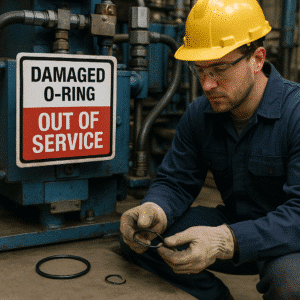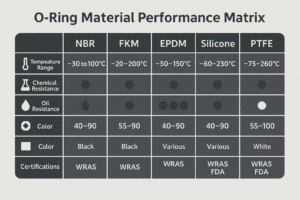Der falsche Einbau einer Öldichtung kann zu vorzeitigem Ausfall, Öllecks und kostspieligen Ausfallzeiten führen. Ob Sie eine Kurbelwellendichtung austauschen oder eine Radialwellendichtung montieren, die richtige Einbau der Öldichtung ist kritisch.
In this guide, I’ll show you how to install oil seals the right way—without damaging the lips or misaligning the casing. This article covers tools, step-by-step procedures, lip direction, sealing surface prep, and tips for ensuring long-lasting performance.
What tools are needed for oil seal installation?
Sie brauchen keine ganze Werkstatt – aber die Verwendung der richtigen Werkzeuge macht den Unterschied.
| Werkzeug | Funktion |
|---|---|
| Öldichtungs-Einbau-/Presswerkzeug | Übt gleichmäßigen Druck aus, ohne die Dichtung zu beschädigen |
| Gummihammer | Sanftes Eintippen, wenn kein Installationstool verfügbar ist |
| Reinigungslösungsmittel | Bereitet die Wellenoberfläche für die Versiegelung vor |
| Schmiermittel (zB Motoröl) | Hilft der Dichtung, an ihren Platz zu gleiten |
| Schlitzschraubendreher / Pick | Entfernt alte Versiegelung schonend |
| Mikrometer / Messschieber | Überprüft die Übereinstimmung von Wellen- und Bohrungsgröße |
Some kits include their own installer. You can also choose a universal press tool when ordering replacement seals like our TG4-Öldichtung.
What direction should the oil seal face to prevent leaks?
Installing backward is the most common mistake.
- Hauptdichtlippe zeigt immer zur Flüssigkeits- bzw. Ölseite (nach innen)
- Staublippe (falls vorhanden) faces outward, toward contaminants
For skeleton seals like TG4 oder TC-Öldichtung, inspect the lip curvature: the spring side always faces oil.
How to install an oil seal without leaks: full process
-
Entfernen Sie die alte Dichtung
Use a puller or flat screwdriver. Avoid damaging the housing. -
Clean bore and shaft
Remove oil, dirt, and rust using solvent and lint-free wipes. -
Inspect shaft
Suchen Sie nach Kratzern oder Rillen und polieren Sie sie bei Bedarf leicht. -
Lubricate lips
Apply a thin coat of oil or grease—never install dry. -
Richten Sie die neue Dichtung aus
Center it squarely over the bore opening. -
Gleichmäßig eindrücken oder einklopfen
Use a seal installer or socket. Do not hammer the center. -
Confirm flush seating
Outer edge should be level or slightly recessed—not protruding. -
Double-check orientation
Ensure the spring side faces oil and dust lip faces out.
Working on more complex components? Check our Anleitung zum Austausch der Kurbelwellen-Öldichtung for deeper instructions.
Can damaged oil seals be reused?
Never reuse old or deformed oil seals—even minor lip damage leads to leaks. Replacement is essential, especially when servicing timing covers or differentials.
We stock quality replacement seals in NBR and FKM, including OEM types. Explore our TC Und TG4 Optionen.
Do you need sealant when installing oil seals?
Usually, NEIN — but exceptions include:
| Zustand | Sealant Required? |
|---|---|
| Glatte Metallbohrung | ❌ Nein |
| Worn or oversize housing | ✅ Verwenden Sie Loctite oder Flanschdichtungsmittel |
| Static rubber-coated seals (TG4) | ❌ Nein |
| High-vibration areas | ✅ Light non-hardening sealant on outer edge |
Avoid getting sealant on the lip.
Abschluss
Correct oil seal installation ensures leak-free performance and longer service life. Use the right tools, align lips correctly, and never install dry.
Ready for high-quality oil seal replacements?
We offer durable NBR and FKM shaft seals in all sizes. OEM and custom orders supported.
📧 E-Mail: [email protected]
📱 WhatsApp: +86 17622979498
Related topics
TC Skeleton Oil Seal – Metal Shell
TG4 Double-Lip Rotary Oil Seal
Anleitung zum Austausch der Kurbelwellen-Öldichtung


